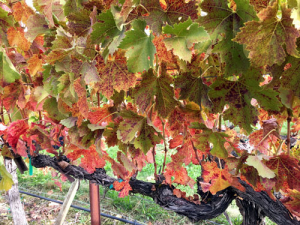This research, sponsored by New Zealand Winegrowers, provides insight on the prevalence and impact of viruses in the commercial vineyard estate; helps inform useful conclusions on vineyard biosecurity and raises a number of important research questions that could help to protect the wine industry’s long-term sustainability.
Virus prevalence
One of the most significant results of Blouin’s work is to illustrate just how common plant viruses are in the vineyard. Of the 18 samples taken from the New Zealand Winegrowers reference collection, 17 samples indicated the presence of one or more grapevine viruses. One plant was infected with eight different grapevine viruses and two viroids! Similarly, in the commercial estate, samples collected in specific Sauvignon Blanc blocks from both Marlborough and Hawke’s Bay indicated the presence of:
• One infection of grapevine leaf roll-associated virus 2
• Three infections of grapevine leaf roll-associated virus 3
• One new vitivirus in one plant
• High incidence of Maculaviruses - 10% of total vines sampled
• Very high incidence of Marafiviruses - 59% of total vines sampled
• High incidence of grapevine rupestris stem pitting virus
• Very high viroids incidence
These results are likely to differ from one block to another.
These results highlight the significant variety in the New Zealand vineyard virome and show, with the diagnostic tools that are now available, further sampling of the commercial estate will likely lead to more viruses being discovered. Grapevines and the grapevine viruses they contain have most likely co-evolved over a long time period and it is a false expectation to consider that all the vines in your vineyard will be virus free. Most importantly, these results highlight that the presence of many specific viruses does not equal disease and that, in many cases, plants which contain some viruses can be considered healthy, and still capable of producing the high quality grapes that go into making outstanding wine.
Virus management remains a high priority throughout the wine industry. The New Zealand Winegrowers Grafted Grapevine Standard seeks to minimize the probability of infected material being released to the industry. The potential impact of these pathogenic viruses is further minimised by the quality control systems in place at many grapevine nurseries; and the standard operating procedures for virus management in many vineyards.
What viruses are not in New Zealand?
This research also highlights that two important grapevine viruses; grapevine red blotch virus and grapevine Pinot Gris virus; are not present in New Zealand.
Grapevine red blotch virus has not been regularly reported outside North America. Symptoms generally occur in late summer as irregular red blotching in leaf blades. The veins of affected leaves can turn partially or fully red. Symptoms are often confused with grapevine leafroll disease caused by another virus, grapevine leafroll associated virus 3. The primary impact of grapevine red blotch is on the accumulation of total soluble solids. Typically, infected vines can be as much as four to five units lower than healthy vines. In North America this virus primarily affects red wine cultivars such as Cabernet Sauvignon, Pinot Noir, Cabernet Franc and Merlot but has also been detected in white wine cultivars such as Chardonnay, Riesling, and Viognier.
Grapevine Pinot Gris virus is common in many international wine regions and was first identified in Australia in 2017. The symptoms associated with infection include delayed budburst, leaf distortion and mottling, shortened internodes, increased berry acidity and yield loss (reports of up to 80%). These symptoms are most pronounced in spring and may be confused with cold or herbicide damage. Grapevine Pinot Gris virus can affect a wide range of cultivars including Pinot Gris and Chardonnay.
Next steps – further research important for improved biosecurity
Blouin’s research is a great step to better understanding the New Zealand vineyard virome, yet is far from being comprehensive. Further research, and a larger sample size, would help to confirm the prevalence of a range of viruses and the absence of others, like grapevine red blotch virus or grapevine Pinot Gris virus. Further evidence of absence is important for wine industry biosecurity as it would suggest that if either of these destructive viruses are detected in New Zealand, that this would be most likely from a recent grapevine introduction. From a biosecurity perspective, it is much more cost effective to respond to a recent introduction than a virus that has been undetected for many years.
Conclusion – being aware of the unusual
Often, it can be difficult to tell whether the unusual symptoms you see in your vineyard are caused by plant viruses, or a range of other biotic and abiotic factors. A clear diagnosis is critical. That’s why if you do see something that just doesn’t look right you should catch it, snap it, report it. Call the MPI biosecurity hotline 0800 80 99 66 and call New Zealand Winegrowers Biosecurity and Emergency Response Manager Ed Massey, 0211924924 This email address is being protected from spambots. You need JavaScript enabled to view it.. After all, it’s your asset, and your responsibility to protect it.



